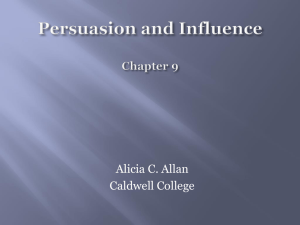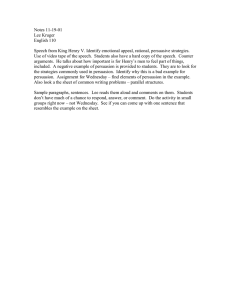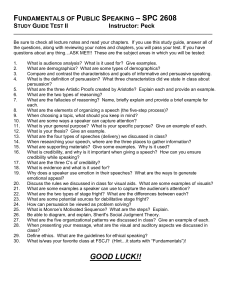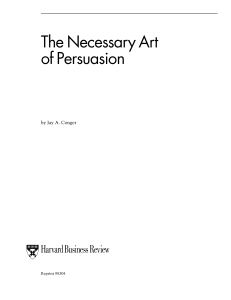Mr. Valanzano Business Communications
advertisement
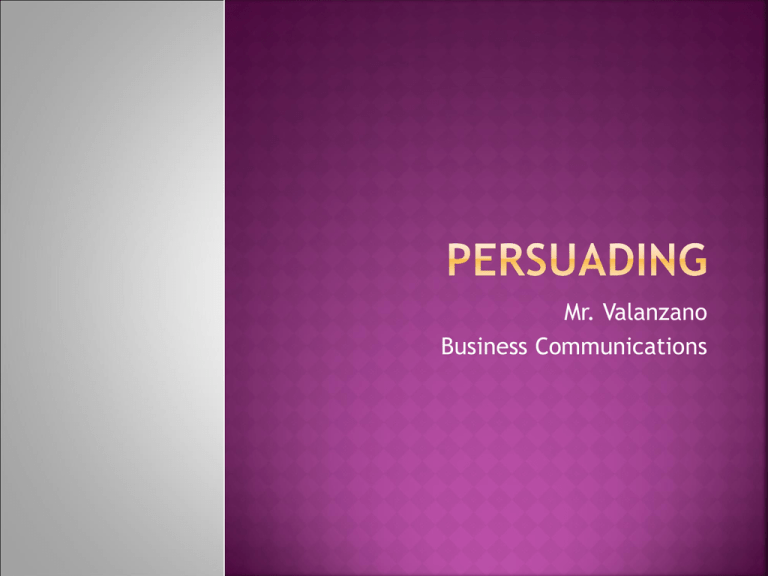
Mr. Valanzano Business Communications Persuasion – the effort to influence attitudes or behavior Persuasion may reinforce a belief or convince someone a certain point of view is right Persuasion may result in a direct action or not succeed at all Everyday examples: Waking up is persuaded by an alarm clock Paying a bill is persuaded by receiving a bill in the mail Buying a new outfit is persuaded by getting an invitation to a party 3 Basic Appeals (“Keys”) to Persuasion: credibility, reasoning, and appeal to emotions Credibility – the confidence the persuader inspires Persuasion is more likely to occur when the persuader is liked and trusted Displaying knowledge and competence will often cause a favorable reaction Show care and concern for the subject People are more willing to accept change when they feel their own interests are being served Display high moral standards Make the best personal impression possible Reasoning – plan, think, and research in order to develop the supportive reasoning for any “why” questions that may be asked Appeal to Emotions – use language to affect emotions; avoid words that can make someone feel uncomfortable By appealing to emotions, the persuader is able to get into the other person’s shoes Always consider how the person(s) you are trying to persuade will react The needs of whoever you are trying to persuade need to be understood so you can meet their unsatisfied needs. Fulfilling potential and feeling happy about yourself Recognizing achievement to make one feel better about oneself Family, sense of belonging, helping society Security and being in control Physical needs such as: food, shelter, etc. Favorable – an audience that is already in favor of your suggestion or viewpoint (easiest to persuade) No Opinion – an audience that is possibly uninformed, indifferent or does not know enough about the subject Opposed – an audience that is slightly to completely against your viewpoint If there were no conflicts, we would all agree on everything. Conflicts create a need for persuasion. Types of conflicts: Pseudo – a false conflict; all signs point to a disagreement but there is none; some people just feel the need to choose one option or the other Content – when the audience agrees with the problem, but not the solution Values – when persuasion attacks values it can create barriers and build walls; find a way for the audience can agree then slowly try to persuade Ego – when a person feels an argument must have a winner and loser; propose compromises Cooperation, not competition, is crucial when handling conflicts. Withdrawal – physically or psychologically removing yourself from the conflict Surrender – immediately giving in; this can be taken as not caring and the conflict never gets addressed Assertiveness – stating your position on a conflict positively and firmly without hostility; pros and cons are considered Persuasion – used when a conflict has a logical basis; works when people are open, not secretive Negotiation – managing a conflict through tradeoffs 1) Determine a goal 2) Give logical evidence 3) Organize the material 4) Use motivating language 5) Build credibility 6) Deliver convincingly Attract ttention – ask a question, startle, offer something free, flatter, persistence Create esire – attack the unsatisfied need(s) ppeal to Needs – show how your idea will satisfy the need(s) (problem/solution, compare advantages, satisfaction of requirements, testimonials, negativity) ove to Action – tell the audience how your solution meets their needs; make sure it is clear and to the point
